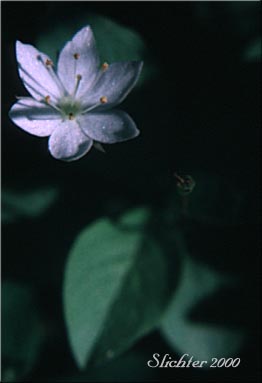Arctic Starflower, Northern Starflower
Lysimachia europaea
Synonyms: Trientalis arctica, Trientalis europaea, Trientalis europaea ssp. arctica, Trientalis europaea var. aleutica, Trientalis europaea var. arctica


 Photo
at right of northern starflower from Rainy Lake, Mount Hood N.F.......July
11, 1991.
Photo
at right of northern starflower from Rainy Lake, Mount Hood N.F.......July
11, 1991.
Northern starflower is a small, bog-loving perennial which reproduces via underground tubers which are horizontal. The stems are erect and 7-20 cm tall with several reduced leaves on the lower portion of the stem and a whorl of larger leaves at the tip of the stem. These main leaves are petiolate, elliptic to obovate in shape and 1.5-5 cm long.
A single flower may be found at the top of a thread-like stalk, several centimeters above the whorl of leaves. The flowers are star-shaped, white, or occasionally pink-tinged with 5-7 petals. The flowers are 12-16 mm wide.
Northern starflower is a plant which may be found in boggy areas such as moist lake or stream shores, and in moist to wet open forests and meadows. It may be found from the lowlands to well up in the alpine zone.
Northern starflower may be found from Alaska south to Alberta, British Columbia, northern Idaho, and south in the Cascades to northern Oregon. It is found along the Oregon coast to southern Oregon.
In the Columbia River Gorge, it may be found between the elevations of 2800'-4000' between Larch Mt. and Mt. Defiance.